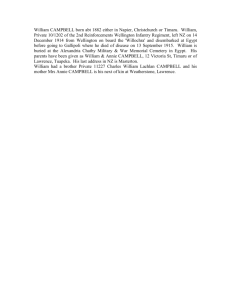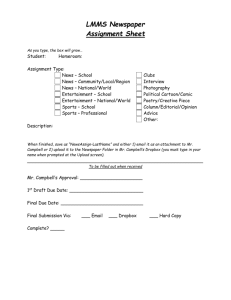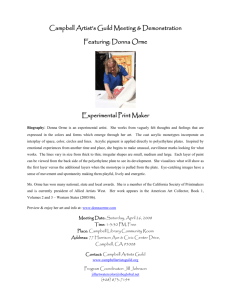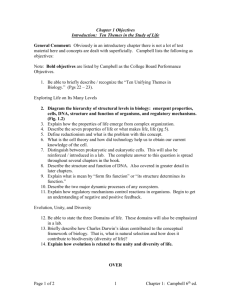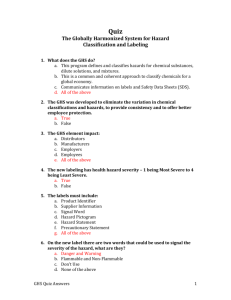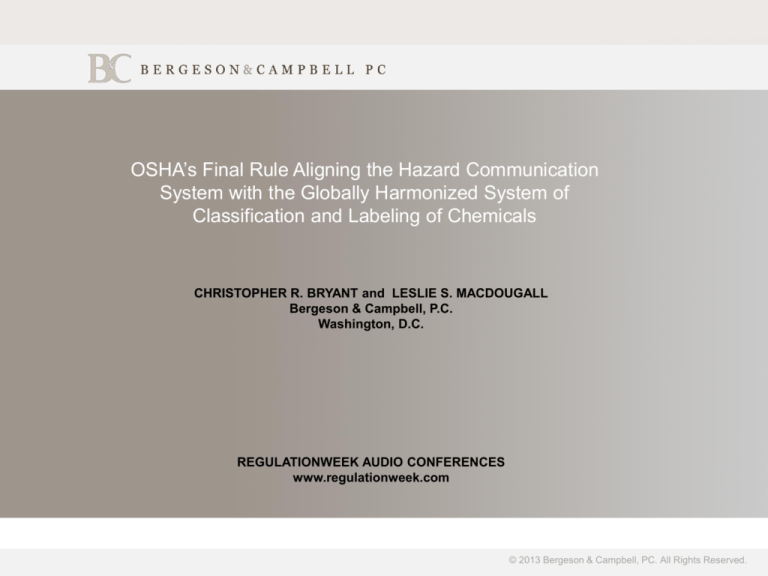
OSHA’s Final Rule Aligning the Hazard Communication
System with the Globally Harmonized System of
Classification and Labeling of Chemicals
CHRISTOPHER R. BRYANT and LESLIE S. MACDOUGALL
Bergeson & Campbell, P.C.
Washington, D.C.
REGULATIONWEEK AUDIO CONFERENCES
www.regulationweek.com
© 2012 Bergeson & Campbell, P.C., All Rights Reserved
© 2013 Bergeson & Campbell, PC. All Rights Reserved.
Topics Covered Today
Overview, Background, and Scope of the Final Rule
Revised Hazard Categories
Labels
Safety Data Sheets
Training and Related Information
Trade Secrets
Comparison to International Standards
Questions and Wrap Up
© 2012 Bergeson & Campbell, P.C., All Rights Reserved
2
Overview
On March 26, 2012, OSHA released its long awaited final
rule revising the HCS by aligning it with the United
Nations GHS (77 Fed. Reg. 17574)
The rule took effect on May 25, 2012
Implementation will be phased, with full implementation
by 2016
During the transition period, chemical manufacturers,
importers, distributors, and employers may comply with
either 29 C.F.R. Part 1910.1200 (the final standard), the
current standard, or both
© 2012 Bergeson & Campbell, P.C., All Rights Reserved
3
Overview (cont’d)
The rule makes four major changes to the HCS:
Hazard classification: Chemical manufacturers and
importers are required to determine the hazards of the chemicals
they produce or import
Labels: Chemical manufacturers and importers must provide a
label that includes a signal word, pictogram, hazard statement,
and precautionary statement for each hazard class and category
Safety Data Sheets (SDS): The new format requires 16
specific sections, ensuring consistency in presentation of
important protection information
Information and training: To facilitate understanding of the
new system, the new standard requires that workers be trained
by December 1, 2013, on the new label elements and SDS
format, in addition to the current training requirements
© 2012 Bergeson & Campbell, P.C., All Rights Reserved
4
Overview (cont’d)
Effective Completion Date
Requirement(s)
Who
Train employees on the new label
December 1, 2013
Employers
elements and SDS format
June 1, 2015
Comply with all modified provisions of
this final rule, except:
Chemical manufacturers, importers,
December 1, 2015
Distributors may ship products labeled distributors, and employers
by manufacturers under the old system
until December 1, 2015
Update alternative workplace labeling
and hazard communication program as
June 1, 2016
necessary, and provide additional
Employers
employee training for newly identified
physical or health hazards
Comply with either 29 C.F.R. Part
All chemical manufacturers, importers,
Transition Period
1910.1200 (this final standard), or the
distributors, and employers
current standard, or both
© 2012 Bergeson & Campbell, P.C., All Rights Reserved
5
Why Align with GHS?
Complying with myriad, multi-jurisdictional regulations
on chemical hazard communication can be a burden for
manufacturers, importers, transporters, and distributors
This burden is magnified by the need to develop multiple
sets of labels and SDSs for each product in international
trade
OSHA first recognized the problems associated with
differing national and international requirements when
it issued the original HCS in 1983, when OSHA also
noted the benefits of global harmonization and
committed to reviewing its rules to ensure consistency
with global standards
© 2012 Bergeson & Campbell, P.C., All Rights Reserved
6
Why Align with GHS? (cont’d)
GHS was adopted by the UN Committee of Experts on the
Transport of Dangerous Goods and the Globally
Harmonized System of Classification and Labeling of
Chemicals in December 2002
In 2003 GHS was endorsed by the Economic and Social
Council of the United Nations. Countries were encouraged
to implement the GHS as soon as possible, and have fully
operational systems by 2008
This goal was adopted by countries in the Intergovernmental Forum on Chemical Safety, and was endorsed by
the World Summit on Sustainable Development. The U.S.
participated in these groups, and agreed to work toward
achieving these goals
© 2012 Bergeson & Campbell, P.C., All Rights Reserved
7
Why Align with GHS? (cont’d)
The scope of the rule is broad -- it covers over 43 million
workers who produce or handle hazardous chemicals in
more than five million workplaces across the country
OSHA estimates that the revised HCS will prevent over
500 workplace injuries and illnesses and 43 fatalities
annually
Other benefits according to OSHA
Improving the quality and consistency of hazard information in
the workplace, making it safer for workers to do their jobs, and
easier for employers to stay competitive;
© 2012 Bergeson & Campbell, P.C., All Rights Reserved
8
Why Align with GHS? (cont’d)
Enhancing worker comprehension of hazards, especially for low
and limited-literacy workers, reducing confusion in the
workplace, facilitating safety training, and resulting in safer
handling and use of chemicals;
Providing workers quicker and more efficient access to
information on the SDSs;
Cost savings to American businesses of more than $475 million
in productivity improvements, fewer SDS and label updates and
simpler new hazard communication training; and
Reducing trade barriers by harmonizing with systems around the
world
© 2012 Bergeson & Campbell, P.C., All Rights Reserved
9
Hazard Categories -- Revisions
© 2012 Bergeson & Campbell, P.C., All Rights Reserved
10
Topics to Be Covered
Overview -- Revisions/Principles
Basis for Classification
Methodology for Classification of Substances and
Mixtures (Products)
© 2012 Bergeson & Campbell, P.C., All Rights Reserved
11
Overview -- Revisions/Principles
Creates a building-block approach
Modifications to hazard classifications
Only those provisions that allow for alignment with GHS
Underlying framework unchanged
Enhances level of protection and accuracy
© 2012 Bergeson & Campbell, P.C., All Rights Reserved
12
Overview -- Revisions/Principles
(cont’d)
Maintain consistency with GHS except where
determined contrary
Several areas
Revisions necessary to OSHA-specific standards to
maintain consistency
I.e., substance-specific standards; flammable liquids; laboratory
standard…
Manufacturers are still responsible for determining the
hazards of substances they produce
© 2012 Bergeson & Campbell, P.C., All Rights Reserved
13
Overview -- Revisions/Principles
(cont’d)
Classification should be based on ALL available
information
Can and should determine if the manufacturer accurately
classifies the substance/mixture
Can modify classification provided by manufacturer provided
that it can be supported that the SDS misstates or omits required
information
© 2012 Bergeson & Campbell, P.C., All Rights Reserved
14
Overview -- Revisions/Principles
(cont’d)
Mixtures
Tiered Approach
• SDS should be provided on mixture (as a whole);
• Bridging principles to extrapolate from other data, i.e., dilution
principle;
• Hazard estimate based on known information of compositional
ingredients
– Limit restrictions may apply for classification (cut-offs/concentration
limits)
– Additivity approach
Tiered Approach -- Exceptions
© 2012 Bergeson & Campbell, P.C., All Rights Reserved
15
Overview -- Revisions/Principles
(cont’d)
Germ cell mutagenicity, carcinogenicity, and reproductive
toxicity
Consider the cut-off levels as the primary tier and allowing the
classification to be modified on a case-by-case basis based on
available test data for the mixture as a whole
Sensitivity of available test methods to detect these types of
effects at small concentrations in the mixture as a whole
© 2012 Bergeson & Campbell, P.C., All Rights Reserved
16
Overview -- Revisions/Principles
(cont’d)
As with substance SDS -- information in the substance SDS can
be relied upon unless it is known that the SDS misstates or omits
required information
© 2012 Bergeson & Campbell, P.C., All Rights Reserved
17
Hazard Categories -- Revisions
Modifications to the following hazard classification
categories
Physical
Health
© 2012 Bergeson & Campbell, P.C., All Rights Reserved
18
Hazard Categories -- Changed
Definitions
Physical hazard definitions are located in a new
Appendix B (formerly paragraph (c));
Flashpoint (crucial for flammable liquids, fuels, and oils)
(methods included in Appendix B), hazard warning, and
material safety data sheets (MSDS) definitions deleted;
and
Definitions revised or proposed to be GHS-consistent
Skin corrosive definition modified
• Skin corrosion is the production of irreversible damage to the skin;
namely, visible necrosis through the epidermis and into the dermis,
following the application of a test substance for up to four hours
© 2012 Bergeson & Campbell, P.C., All Rights Reserved
19
Hazard Categories -- Changed
Definitions (cont’d)
• Corrosive reactions are typified by ulcers, bleeding, bloody scabs,
and, by the end of observation at 14 days, by discoloration due to
blanching of the skin, complete areas of alopecia, and scars.
Histopathology should be considered to evaluate questionable
lesions
© 2012 Bergeson & Campbell, P.C., All Rights Reserved
20
Hazard Classes
Each hazard “class,” i.e., physical, health, is sub-divided
into a “hazard category”
Hazard categories are:
Based on degree of severity;
Several categories per class
• Cat 1 – 4/5/6 depending upon the hazard class
© 2012 Bergeson & Campbell, P.C., All Rights Reserved
21
Hazard Classes (cont’d)
Increase in hazard category number indicates a decrease in
severity
• Cat 1 is highest level of severity
Hazard category number is inconsistent with HMIS number
rating
• Cat 4 is highest level of severity
• HMIS anticipated to modify its rating system (eventually)
© 2012 Bergeson & Campbell, P.C., All Rights Reserved
22
Basis for Classification
Substances
Classification based upon full range of available information
• Scientific literature
• Study reports
• Other reliable evidence
© 2012 Bergeson & Campbell, P.C., All Rights Reserved
23
Hazard Class and Hazard
Category
© 2012 Bergeson & Campbell, P.C., All Rights Reserved
24
Hazard Class and Hazard
Category (cont’d)
Hazard Class
Hazard Category
Acute Toxicity
1
2
3
4
Skin Corrosion/Irritation
1A
1B
1C
2
Serious Eye Damage/ Eye
Irritation
1
2A
2B
Respiratory or Skin
Sensitization
1
Germ Cell Mutagenicity
1A
1B
2
Carcinogenicity
1A
1B
2
Reproductive Toxicity
1A
1B
2
STOT –
Single Exposure
1
2
STOT –
Repeated Exposure
1
2
Aspiration
1
Simple Asphyxiants
Single Category
Lactation
3
© 2012 Bergeson & Campbell, P.C., All Rights Reserved
25
Criteria for Classification
Substances
Result of specific test (dose-effect relationship)
Example: Irreversible Eye Effects: Category 1
A substance is classified as Serious Eye Damage Category 1
(irreversible effects on the eye) when it produces:
(a)At least in one tested animal, effects on the cornea, iris or
conjunctiva that are not expected to reverse or have not fully reversed
within an observation period of normally 21 days; and/or
(b)At least in 2 of 3 tested animals, a positive response of:
(i)Corneal opacity ≥3; and/or
(ii)Iritis >1.5;
Calculated as the mean scores following grading at 24, 48 and 72 hours
after installation of the substance.
© 2012 Bergeson & Campbell, P.C., All Rights Reserved
26
Criteria for Classification (cont’d)
Mixtures
Classification based upon information on the mixture when
available, or
When data are not available on the mixture but on the
ingredients and similar mixtures, extrapolation or bridging of
data to classify the mixture is allowed, or
• I.e., if there is a mixture that is comprised of 1% of an acutely toxic
material, regardless of severity of that effect, and 99% water, the
current HCS would require the mixture be defined as acutely toxic,
however, under the new HCS, the classification would be unlikely
due to dilution effect
• Where an ingredient with unknown acute toxicity is used in a
mixture at a concentration >1% and the mixture is not classified
based on testing of the mixture as a whole, a statement that X% of
the mixture consists of ingredient(s) of unknown acute toxicity is
required
© 2012 Bergeson & Campbell, P.C., All Rights Reserved
27
Criteria for Classification (cont’d)
Classification based upon the classification of some
constituent substances based on cut-offs (concentration
limits) specific to the hazard or additivity
Additivity approach
Sum of ingredients
classified as:
Skin Category 1
Skin Category 2
(10 x Skin Category 1) +
Skin Category 2
Skin corrosive Category Skin Irritant Category 2
1
>5%
≥1% but <5%
≥10%
≥10%
© 2012 Bergeson & Campbell, P.C., All Rights Reserved
28
Criteria for Classification (cont’d)
Mixtures
Ingredient:
Concentration:
Mixture classified as:
Skin
Acid with pH ≤2
Base with pH ≥11.5
Other corrosive
(category 1)
ingredients for which
additivity does not
apply
≥1%
≥1%
≥1%
Category 1.
Category 1.
Category 1.
Other irritant
(category 2)
ingredients for which
additivity does not
apply, including acids
and bases
≥1%
Category 2.
© 2012 Bergeson & Campbell, P.C., All Rights Reserved
29
Health -- Hazard Class and Hazard
Category
Carcinogenicity -- Only one positive study necessary
Clarification offered by OSHA -- where the weight of evidence for the
carcinogenicity of a substance does not meet the above criteria, any
positive study conducted in accordance with established scientific
principles, and which reports statistically significant findings
regarding the carcinogenic potential of the substance, must be noted on
the SDS
OSHA is allowing classifiers to use determinations of International
Agency for Research on Cancer (IARC)/National Toxicology
Program (NTP) for classification instead of performing their own
hazard evaluation
Included in Appendix F
© 2012 Bergeson & Campbell, P.C., All Rights Reserved
30
Environmental
Not OSHA’s mandate
No environmental categories defined by OSHA HCS
© 2012 Bergeson & Campbell, P.C., All Rights Reserved
31
Hazards Not Otherwise Classified
(HNOC)
Minimum information for an SDS includes “other hazards
which do not result in classification (e.g., “dust explosion
hazard”) or are not covered by the GHS” in Section 2, Hazards
Identification
OSHA is specifically attempting to address hazards that are
not currently addressed in the 3rd revision of the Purple Book
I.e., simple asphyxiants and combustible dust for which OSHA
standards exist
HNOCs are not required to be presented on labels but are
required to be presented in the SDS and during training
© 2012 Bergeson & Campbell, P.C., All Rights Reserved
32
Hazard Communication Labeling
under the Revised HCS
© 2012 Bergeson & Campbell, P.C., All Rights Reserved
33
Topics Covered
GHS Implementation
Obligations
Label content -- Transported containers
Label content -- Workplace containers
© 2012 Bergeson & Campbell, P.C., All Rights Reserved
34
Effective Dates for Labeling and
Documentation
May 25, 2012 (60 days following publication) -- Effective
date
May 25, 2012 – June 1, 2015 -- Transitional period
June 1, 2015 -- Compliance with all modified provisions
of the final rule
December 1, 2015 -- Distributors must only ship GHS
labeled containers
© 2012 Bergeson & Campbell, P.C., All Rights Reserved
35
Effective Dates for Labeling and
Documentation (cont’d)
June 1, 2016 -- Employers must update workplace
labeling and employee training within six months of new
hazards becoming known
Labels must be updated within six months of new
information available to preparer
© 2012 Bergeson & Campbell, P.C., All Rights Reserved
36
Label Requirements for Shipped
Containers
Beginning June 1, 2015, all shipped containers must be
labeled with the required information, as displayed on
this slide
This is the standard information for GHS across most countries
that have implemented GHS
Containers must also meet the safety standards set out in the
final rule
© 2012 Bergeson & Campbell, P.C., All Rights Reserved
37
Label Requirements for Shipped
Containers (cont’d)
Labels for hazardous substances
Product identifier
• A product identifier can be a chemical name, trade name, or other
designation that is unique to the substance or product. This
designation must be the same across all hazard communication
documents and other sources of information
Signal word
Hazard statement(s)
Pictogram(s)
Precautionary statement(s)
© 2012 Bergeson & Campbell, P.C., All Rights Reserved
38
Label Requirements for Shipped
Containers (cont’d)
Name, address, and telephone number of the chemical
manufacturer, importer, or other responsible party
In English, prominently displayed, includes all
associated hazard categories
© 2012 Bergeson & Campbell, P.C., All Rights Reserved
39
Label Requirements for Shipped
Containers (cont’d)
All hazard communication elements must be easily
legible
No required label size
No required pictogram size
Must be easily legible
© 2012 Bergeson & Campbell, P.C., All Rights Reserved
40
Label Requirements for Shipped
Containers (cont’d)
Articles -- Exempt from labeling
No intentional release of substances
Hazardous Substances and Products -- Each container
must be labeled
Hazardous Materials Transportation Act (49 U.S.C. 1801 et seq.)
Solid materials
Solid metal/wood/plastic or whole grains
Not subject to article exemption
Label included in initial shipment only
© 2012 Bergeson & Campbell, P.C., All Rights Reserved
41
Workplace Labels
Do not remove original labels from containers, unless
immediately re-labeled
Signs, placards, process sheets, batch tickets, operating
procedures, or other such written materials can be used
in conjunction with written materials instead of affixed
labels
Written materials must be readily accessible to
employees in their work area, throughout each work shift
© 2012 Bergeson & Campbell, P.C., All Rights Reserved
42
Workplace Labels (cont’d)
Employer must ensure that each container is labeled (or
tagged or marked) in the workplace
(i)
(ii)
(iii)
(iv)
(v)
(vi)
Product identifier;
Signal word;
Hazard statement(s);
Pictogram(s);
Precautionary statement(s); and,
Name, address, and telephone
number of the chemical
manufacturer, importer or other
responsible party
Product identifier, Words,
Pictures, Symbols or combination
thereof which provides at least
general hazard information;
In conjunction with other
information available to employees
provides specific hazard
information regarding the physical
and health hazards of the
hazardous chemical.
© 2012 Bergeson & Campbell, P.C., All Rights Reserved
43
Workplace Labels (cont’d)
Product 123
DANGER
Heating may cause a fire or explosion.
Keep away from heat/sparks/open flames/hot surfaces. – No smoking.
Keep/Store away from clothing/oxidising materials/combustible
materials.
Keep only in original container.
Wear protective gloves/eye protection/face protection.
24 Chemhotline
(555) 123-1234
Chemchain
123 Sunset boulevard, L.A.
California, 123-1234
(555) 321-4321
Store at temperatures not exceeding 12 °C/53.6 °F. Keep cool.
Protect from sunlight.
Store away from other materials.
Dispose of contents/container to licensed hazardous waste treatment
agent.
© 2012 Bergeson & Campbell, P.C., All Rights Reserved
44
Workplace Labels (cont’d)
Product 123
SDS
Containing full H-statements,
P-statements and supplier
contact information.
DANGER
Heating may cause a fire or explosion.
© 2012 Bergeson & Campbell, P.C., All Rights Reserved
45
Safety Data Sheet
© 2012 Bergeson & Campbell, P.C., All Rights Reserved
46
SDS
Overview
Implementation Dates
© 2012 Bergeson & Campbell, P.C., All Rights Reserved
47
SDS Overview
Amended HCS modifies the SDS requirements from
proposed rule
HCS mandates 16 section format
SDS outline is located in Appendix D of the HCS
OSHA will not enforce Sections 12 - 15
Disposal, Transport, Regulatory information
These sections require information that is outside the scope of
OSHA’s enforcement authority
© 2012 Bergeson & Campbell, P.C., All Rights Reserved
48
SDS Overview (cont’d)
All data should be completed as specified in the format
criteria
Headings order must be followed
Sub-headings should be completed
Appendix D specifies that in the event that no information is
available then no available information shall be stated
American Conference of Governmental Industrial
Hygienists (ACGIH) Threshold Limit Values (TLV) are
required to be provided
Carcinogenicity classifications assigned by IARC and
NTP must be provided
© 2012 Bergeson & Campbell, P.C., All Rights Reserved
49
SDS Overview (cont’d)
When transitioning to new provisions, U.S. chemical
manufacturers, importers, and downstream users can
rely on the pre-existing SDS except when:
It is known, or in the exercise of reasonable diligence should
know, that the SDS misstates or omits required information
• E.g., varied hazard information available in the public domain
SDS must be updated within three months of when new
hazard information becomes known
© 2012 Bergeson & Campbell, P.C., All Rights Reserved
50
Dates of Implementation
No later than June 1, 2015 -- SDS modifications must
be in place
Optional beginning May 25, 2012
© 2012 Bergeson & Campbell, P.C., All Rights Reserved
51
TRAINING, INFORMATION, AND
TRADE SECRETS
© 2012 Bergeson & Campbell, P.C., All Rights Reserved
52
Training -- Background
Employee training is one of the three information
communication components in the HCS (with labels and
SDSs)
One of the major changes to the HSC is the requirements
related to training
OSHA states that one of the benefits of the new HCS is
that it will: “Enhance worker comprehension of hazards,
especially for low and limited-literacy workers, reduce
confusion in the workplace, facilitate safety training, and
result in safer handling and use of chemicals”
© 2012 Bergeson & Campbell, P.C., All Rights Reserved
53
Training -- Implementation
Effective Completion Date
Requirement(s)
Who
December 1, 2013
Train employees on the new label
Employers
elements and SDS format
June 1, 2016
Provide additional employee
training for newly identified
physical or health hazards
Employers
OSHA chose this deadline for training because it believes
that employees will begin seeing the new style labels
considerably earlier than the compliance date for
labeling
© 2012 Bergeson & Campbell, P.C., All Rights Reserved
54
Training -- What Remains the
Same
Training is already a component of the HCS
Definitions of “employer” and “employee” are unchanged
from former HCS to current HCS
Because GHS does not have any training requirements,
OSHA’s modification to HCS is only what is necessary to
ensure appropriate compliance with the revised
standard, and does not introduce any new approaches or
requirements
© 2012 Bergeson & Campbell, P.C., All Rights Reserved
55
Training -- What Changed
The revised training provisions at 29 C.F.R. §
1900.1200(h):
Conforms new hazard definitions into training requirements
Requires that training ensures employees are familiar with the
new label, SDS formats, and presentation of information
Clarifies that the labels on shipped containers and workplace
labels must be explained
© 2012 Bergeson & Campbell, P.C., All Rights Reserved
56
Training -- What Needs to Be
Communicated
GHS does not include harmonized training requirements
Training will support and enhance the effectiveness of
the new label and SDS requirements
Signal words
Pictograms
Hazard statements
Precautionary statements
Standardized headings and a consistent order of information
© 2012 Bergeson & Campbell, P.C., All Rights Reserved
57
Training -- What Needs to Be
Communicated (cont’d)
Note that there is a transition period: Employers may
wish to explain to employees why labels and SDS may
not be the same for the next few years
© 2012 Bergeson & Campbell, P.C., All Rights Reserved
58
Training -- Resources
United Nations Institute for Training and Research
UNITAR training materials:
http://www2.unitar.org/cwm/publications/ghs.aspx
OSHA guidance and compliance assistance materials:
http://www.osha.gov/dsg/hazcom/index.html
GHS Annex 6 (Comprehensibility testing methodology):
http://www.unece.org/fileadmin/DAM/trans/danger/p
ubli/ghs/ghs_rev04/English/10e_annex6.pdf
© 2012 Bergeson & Campbell, P.C., All Rights Reserved
59
Trade Secrets -- Background
“Trade secret” means any confidential formula, pattern,
process, device, information or compilation of
information that is used in an employer’s business, and
that gives the employer an opportunity to obtain an
advantage over competitors who do not know or use it
The protection of trade secrets involves balancing the
safety and health of workers, consumers, and the public
in general, as well as the protection of the environment,
with the protection of confidential business information
© 2012 Bergeson & Campbell, P.C., All Rights Reserved
60
Trade Secrets -- What Remains
the Same
Existing and revised HCS includes provisions to:
Define what can be considered trade secret information
Delineate the conditions under which this information must be
disclosed to ensure the safety and health of exposed employees
Many elements of GHS regarding trade secrets were
already incorporated in HCS
© 2012 Bergeson & Campbell, P.C., All Rights Reserved
61
Trade Secrets -- What Changes
There is one substantive change to the trade secret
provisions: allowing manufacturers to claim the
percentage composition of mixtures on the SDS as
confidential
© 2012 Bergeson & Campbell, P.C., All Rights Reserved
62
COMPARISON TO OTHER
INTERNATIONAL STANDARDS
© 2012 Bergeson & Campbell, P.C., All Rights Reserved
63
Topics Discussed
Introduction to Global GHS
Key Differences in Hazard Categories
Communication Differences
© 2012 Bergeson & Campbell, P.C., All Rights Reserved
64
Global GHS
1st edition of GHS adopted 2002
Revised 2005 (1st revision), 2007 (2nd revision), 2008 (3rd
revision), and 2010 (4th revision)
Adopted by individual countries
Building-block approach
Often based upon previous classification and labeling system
UN Transport regulations
IATA, ADR, IMDG, ADN
Standardised for global transport
© 2012 Bergeson & Campbell, P.C., All Rights Reserved
65
Implementation Dates
Indonesia
(Transport)
January 1,
2005
Korea
(New
substances)
July 1, 2008
Australia
(Transport)
2007
Japan
(All sectors)
December 1,
2006
Canada
(Transport)
February
20, 2008
© 2012 Bergeson & Campbell, P.C., All Rights Reserved
China
(All sectors)
February 1,
2009
66
Implementation Dates (cont’d)
Mexico
(All sectors,
Voluntary)
June 30,
2011
Indonesia
(All sectors)
March 23,
2010
European
Union
(All
substances)
December 1,
2010
Australia
(All sectors)
January 1,
2012
Korea
(All
substances)
June 30,
2011
© 2012 Bergeson & Campbell, P.C., All Rights Reserved
67
Implementation Dates (cont’d)
European Union
(mixtures on the
market before
December 1,
2010)
December 1, 2012
OSHA HCS
(Training
deadline)
December 1, 2013
Korea
(All mixtures)
June 30, 2013
European Union
(All mixtures)
June 1, 2015
© 2012 Bergeson & Campbell, P.C., All Rights Reserved
68
Differences in Communication
Basic Differences
Language
Emergency contact information
Company contact details
Label size and position
© 2012 Bergeson & Campbell, P.C., All Rights Reserved
69
Key Differences in Hazard
Classification
Pre-existing classification thresholds
Building-block approach
Specific concerns -- allowances made for specific
industry sectors
© 2012 Bergeson & Campbell, P.C., All Rights Reserved
70
Key Differences in Hazard
Classification (cont’d)
Flammable Liquids
Category
1
2
3
4
OSHA HCS
Flash point <23 °C (73.4 °F)
and initial boiling point ≤35 °C
(95 °F)
Flash point <23 °C (73.4 °F)
and initial boiling point >35 °C
(95 °F)
Flash point ≥23 °C (73.4 °F)
and ≤60 °C (140 °F)
EU CLP
Flash point <23 °C (73.4 °F) and
initial boiling point ≤35 °C (95 °F)
Flash point <23 °C (73.4 °F) and
initial boiling point >35 °C (95 °F)
Flash point ≥23 °C (73.4 °F) and
≤60 °C (140 °F)
For the purpose of this Regulation
gas oils, diesel and light heating oils
having a flash point between ≥55 °C
and ≤75 °C may be regarded as
Category 3.
Flash point ≥60 °C (140 °F) and
≤93 °C (199.4 °F)
© 2012 Bergeson & Campbell, P.C., All Rights Reserved
71
Key Differences in Hazard
Classification (cont’d)
Sensitisation
Category
1A
1B
OSHA HCS1
Substances showing a high
frequency of occurrence in
humans and/or a high
potency in animals can be
presumed to have the
potential to produce
significant sensitization in
humans. Severity of reaction
may also be considered.
Substances showing a low to
moderate frequency of
occurrence in humans and/or
a low to moderate potency in
animals can be presumed to
have the potential to produce
sensitization in humans.
Severity of reaction may also
be considered.
1Where
Category
1
EU CLP
(i) if there is evidence in
humans that the substance
can lead to sensitization by
skin contact in a substantial
number of persons, or
(ii) if there are positive results
from an appropriate animal
test.
data are not sufficient for sub-categorization, skin sensitizers shall be classified in Category 1.
© 2012 Bergeson & Campbell, P.C., All Rights Reserved
72
Key Differences in Hazard
Classification (cont’d)
Classification of Mixtures
Hazard Class
OSHA GHS
Acute Toxicity
-
Skin Corrosion/Irritation
Serious Eye Damage/Eye
irritation
Respiratory/Skin Sensitisation
Germ cell Mutagenicity: Cat 1
Germ cell Mutagenicity: Cat 2
Carcinogenicity
Specific Target Organ Systemic
Toxicity (Single Exposure)
Target Organ Systemic Toxicity
(Repeated Exposure)
Specific Target Organ Systemic
Toxicity Category 3
-
Generic Threshold Value/Concentration Limit
EU CLP
CHINA
GB 13690-2009
CAT 1-3 0.1%
CAT 4
1%
1%
1%
≥1.0%
≥0.1%
≥0.1%
≥1.0%
≥0.1%
≥1.0%
-
≥1.0%
≥1.0%
≥1.0%
≥1.0%
≥1.0%
≥1.0%
-
≥1.0%
≥20%
Not adopted
Not adopted
-
≥1.0%
≥1.0%
-= No generic threshold.
© 2012 Bergeson & Campbell, P.C., All Rights Reserved
73
Labeling Differences
Labeling of small and difficult shaped containers
OSHA HCS
• No omissions from information to be communicated
• Other methods of providing all information to exposed workers are
available
EU CLP
Specific exemptions -- Specific circumstances and criteria
Fold-out labels, tie-on labels, labeling of outer packaging
Omission of specific labeling elements
© 2012 Bergeson & Campbell, P.C., All Rights Reserved
74
Confidentiality Differences
OSHA HCS
Only hazardous components listed (with percent concentration)
“Trade secret” exemption available
EU CLP
Only hazardous components listed (with percent concentration)
Confidentiality exemptions available for masking component
names
© 2012 Bergeson & Campbell, P.C., All Rights Reserved
75
Confidentiality Differences
(cont’d)
China
Confidentiality can be applied for
Use of generic names is acceptable without application
Use of concentration range is acceptable without application
© 2012 Bergeson & Campbell, P.C., All Rights Reserved
76
Liability Differences
Variation between required labeling
Variation between classification criteria/categories
Problems with re-labeling/re-packaging
Additional or supplementary hazard communication
information reduces the liability
© 2012 Bergeson & Campbell, P.C., All Rights Reserved
77
THANK YOU
© 2012 Bergeson & Campbell, P.C., All Rights Reserved
78


